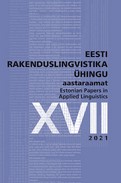SOTSIOPRAGMAATILINE SISSEVAADE KOODIVAHETUSELE: NÄITEID ROOTSIEESTI TEISMELISTE KEELEST
A SOCIOPRAGMATIC APPROACH TO CODE-SWITCHING: A CASE STUDY OF SWEDISH-ESTONIAN TEENAGERS
Author(s): Mari-Liis KorkusSubject(s): Lexis, Pragmatics, Comparative Linguistics, Sociolinguistics, Finno-Ugrian studies
Published by: Eesti Rakenduslingvistika Ühing (ERÜ)
Keywords: multilingualism; code-switching; lexicon; Estonian; Swedish; English;
Summary/Abstract: The aim of this article is to give an overview of code-switching functions in the spoken conversations of five Swedish-Estonian teenagers. Generally, code-switching research has been approached in two ways: grammatically and sociopragmatically. The latter was the favoured approach for this paper since it helped distinguish code-switching patterns and the functions which they represent. These functions, on the other hand, give an insight into why the speaker switches between two or more languages. Data was collected from five young informants, between the ages of 15–17 years, all of whom spoke both Estonian and Swedish fluently. Given the speakers’ age, the analysis also covered the usage of English. The informants were recorded in the form of conversation groups – a less common method for researching codeswitching. A total of 4 hours of speech was recorded, out of which approximately 24.6 % (439 utterances) contained switches between languages. All in all, six code-switching functions were found to systematically appear in the utterances. These include semantic specifications, quasi-translations, vocabulary limitations, expressiveness, word play and cross-utterance language harmony. The results were somewhat biased, which is why, for future notice, it would be suggested to approach different informants with a different method.
Journal: Eesti Rakenduslingvistika Ühingu aastaraamat
- Issue Year: 2021
- Issue No: 17
- Page Range: 141-157
- Page Count: 17
- Language: Estonian

